One of the benefits of an internship at the Center for Italian Modern Art is immediate access to SoHo. Our location offered us access to the SoHo Arts Network – a group of non-profit art spaces in the neighborhood that CIMA helped found in 2014. SAN strives to celebrate the rich history of this unique creative community, while collectively sharing the distinctive cultural contributions each organization brings to the lives of residents and visitors.
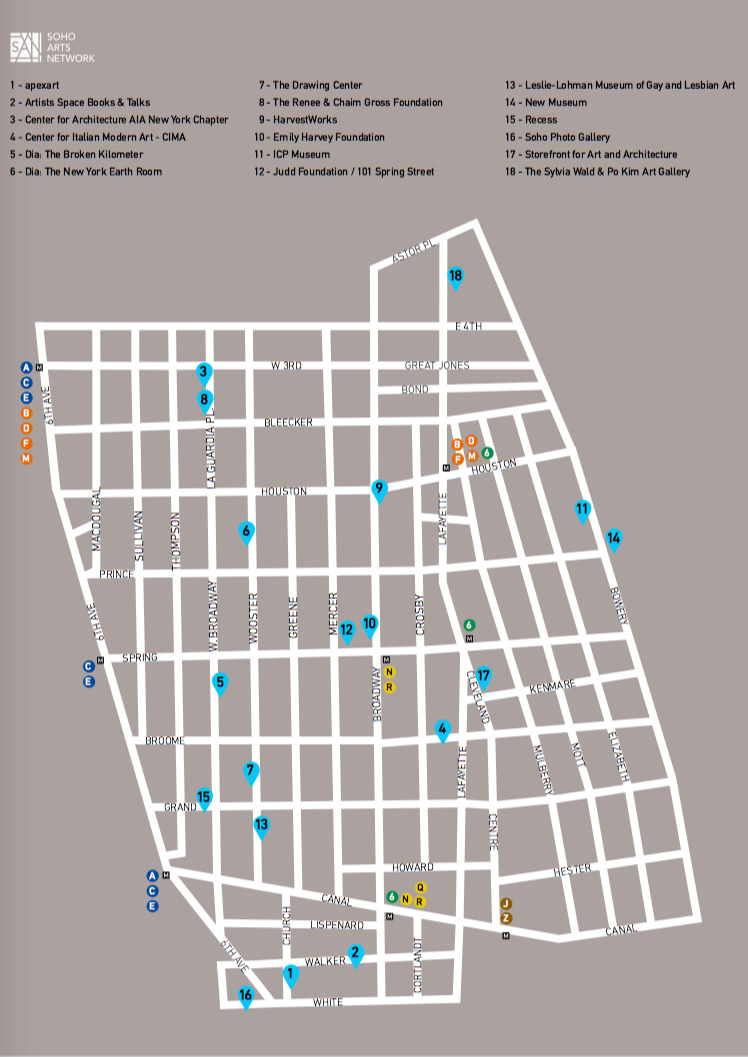
During this internship season, we explored first-hand the forever changing landscape of New York. A few weeks ago CIMA hosted artist Yukie Ohta’s final presentation of the SoHo Memory Project, a “mobile museum, archive, and blog dedicated to preserving and sharing the history of SoHo”. During her iteration of the project at CIMA, Ohta recounted the SoHo in which she grew up. She reminisced about the artists’s spaces and loft-life that once dominated the neighborhood and cited how quickly things changed once retail stores and luxury apartments began to move into these spaces. Currently, SoHo is undergoing a moment of cultural renewal, but it is not, however, a simple restoration of the neighborhood as a place for artists. Instead, the neighborhood continues to define itself as a center for culture. CIMA is participating in this moment as a young nonprofit, making sure to establish itself because of its involvement with its neighbors.
Ohta’s project helped us better understand the history of the neighborhood and piqued our interest in investigating the changes that were happening around us. With this in mind, we spent the summer exploring the neighborhood. We were immediately drawn to the Elizabeth Street Garden and spent many lunch hours enjoying its serene atmosphere. Here, summer intern Eliza Harrison reflects on her time in the garden:
“While interning at CIMA, I stumbled into the Elizabeth Street Garden on one of my first lunchtime strolls. Tucked between Prince and Spring Street, the garden is a green oasis filled with flowers, herbs, and weathered statues. Stepping into the garden, I felt as though I had found the best-kept secret in SoHo until I noticed all of the people lounging and lunching on tucked away stools and benches amongst the towering sunflowers and butterfly-covered coneflowers. Weary travelers laden with heavy suitcases dozed on the grass, workers in pant suits and hard hats chatted over sandwiches, a woman tanned in bathing suit, a group of older women played cards at a table–it seemed as though a microcosm of the neighborhood had gathered in the garden.”
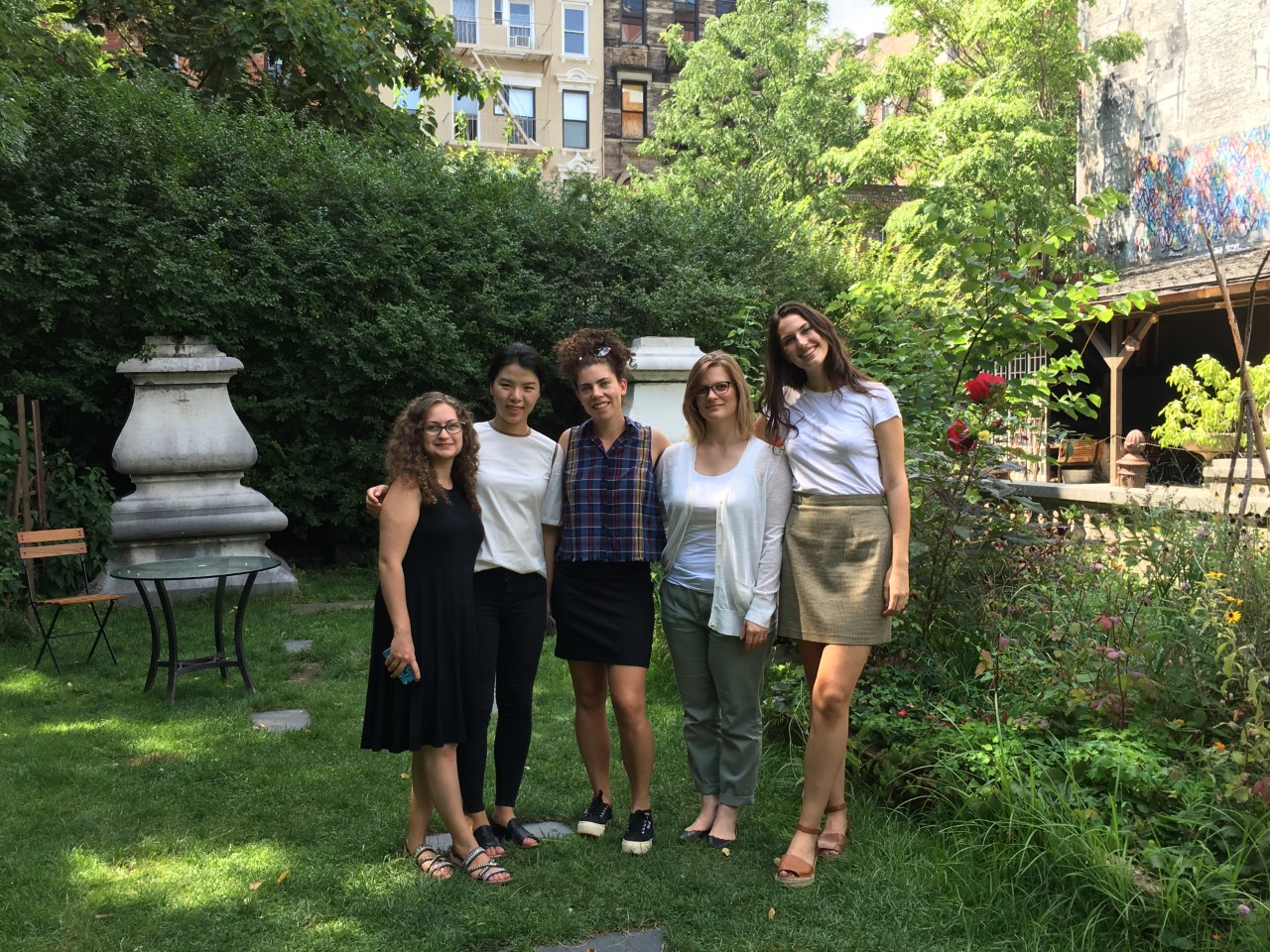
Though the Elizabeth Street Garden has the presence of a permanent fixture in SoHo, the garden was only founded in 1991 on an abandoned city-owned lot between the Little Italy Restoration Apartment buildings. Since then, neighbors and local businesses have joined together to help renovate and increase public access to the unique green space. Currently, this community is working to save the garden from potential development projects that would destroy this rare haven.
Spending our days between CIMA and the garden, the two places seemed to become intricately connected by more than just their shared location. Like the garden, CIMA and the SoHo Arts Network encourage visitors and residents to linger in SoHo and engage with the neighborhood’s community and better understand its ever-shifting history. Both the garden and the SoHo Arts Network represent a new era of revitalization in SoHo that emphasizes creative community engagement and reminds us that neighborhoods are never static spaces but instead remain constantly in flux, reformed and shifted by the people within them. As Jane Jacobs wrote in The Death and Life of Great American Cities, “Cities have the capability of providing something for everybody, only because, and only when, they are created by everybody.”
We recently visited the Storefront for Art and Architecture, a fellow participant in the SoHo Arts Network. Their mission is to generate dialogue and scholarship about the intersections between innovative art, design, and architecture through their exhibitions. Currently on view is Sharing Models – Manhattanisms, which compellingly addresses some of the contentious issues of urban reconstruction from the viewpoint of architects and particularly resonated with our interest in shifting urban space. Sharing Models – Mahattanisms offers a lens through which the viewer can consider, even desire, a world where architecture is driven by the obligation to elevate the quality of life for every city dweller by honing the power of sharing.
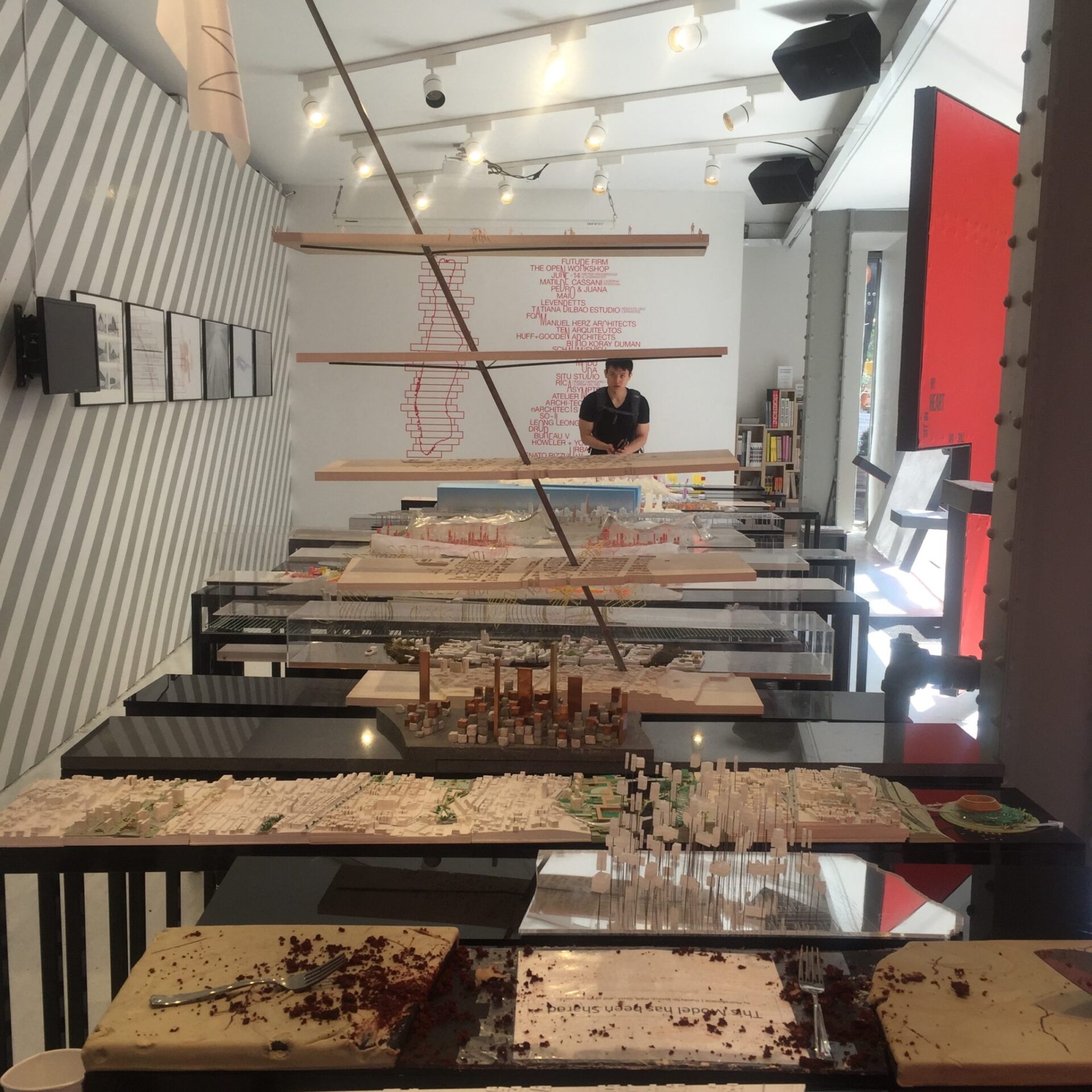
The exhibition is driven by the question, “How will the sharing movement of today affect the way we inhabit and build cities tomorrow?” Confronted with the emergence of a culture that is trending towards new forms of collectivity, thirty international architects collaborated to imagine the future of Manhattan amidst proliferated technology and globalization. Each of the thirty architects designed a 2-dimensional conceptual drawing and 3-dimensional model of a latitudinal section of Manhattan. The 2-dimensional conceptual drawing of each architect’s urban vision appeared to serve as an advertisement for the corresponding three-dimensional model of the future Manhattan they envisioned. Beyond the inviting and innovative graphics, the images and models urged visitors to learn more about Manhattan’s history and meditate on modern urban life.
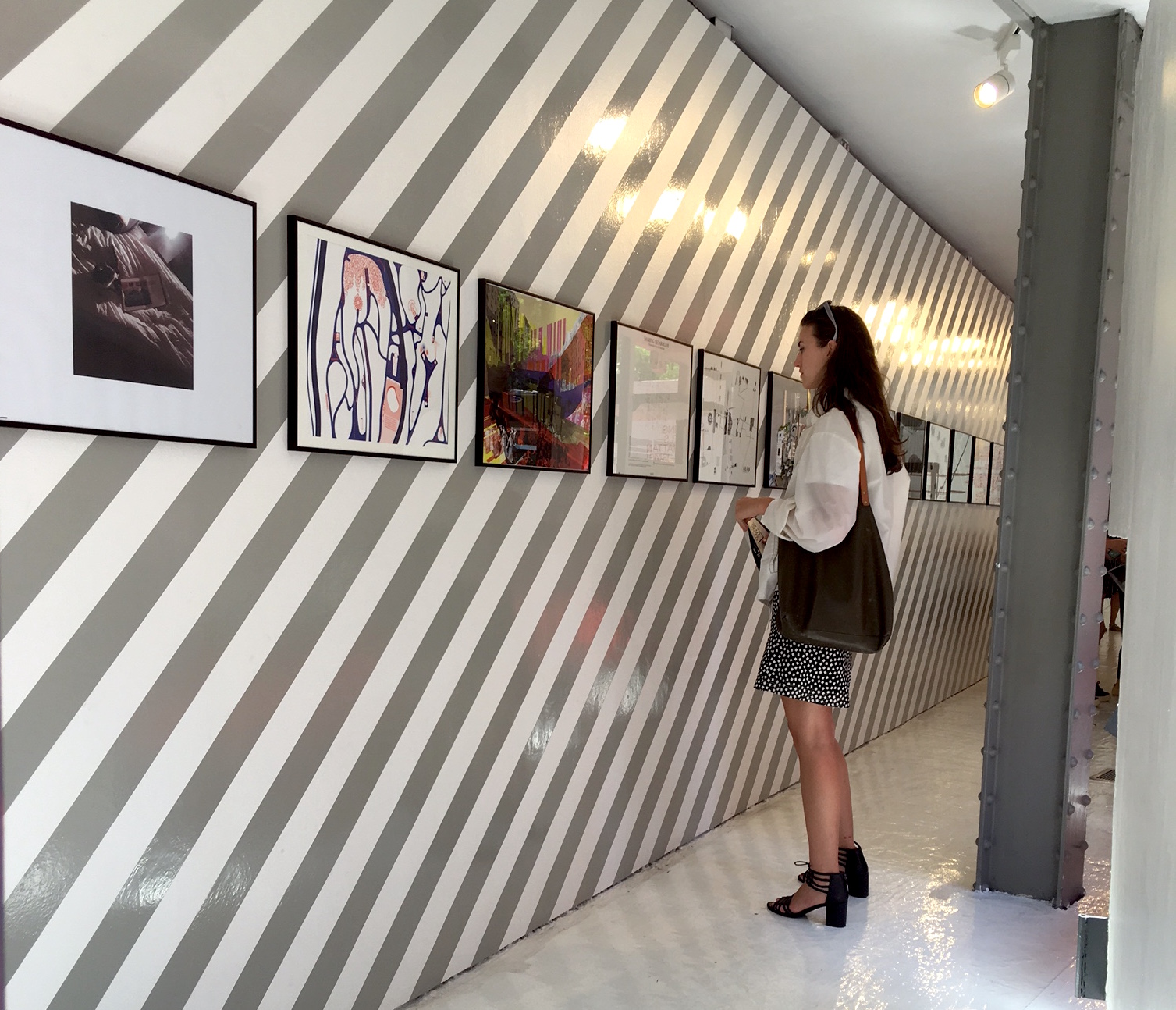
The first model in the exhibition addressed the manipulation of Manhattan’s northernmost border, the naturally-occurring east-west waterway, nevertheless subject to political and economic ambitions. The twelfth focused on 125th Street as a modern locus of gentrification, a place where soaring rent costs are driving out longtime residents, a place where difference is being commoditized. Installation number eighteen diagramed the luxury housing market, revealing a wide gap between the sale value and assessed value of Manhattan’s most expensive properties, which have been undervalued to alleviate wealthy owners from burdensome taxes. Model 27 features Canal Street and our neighborhood of SoHo in the throes of water wars waged by the wealthy to secure the natural resource for themselves, a new take on the water pollution problems that 100 years ago led the canal of Canal street to be filled in and paved over. Between these sections of Manhattan are spaces reimagined for meditation, humanism, cultural expression, athletics, the sacred, the nonhuman, while leaving room to accommodate the unpredictable. To transform underused spaces into multipurpose, non-hierarchical spaces cared for collectively by the the city’s inhabitants was a unifying theme amidst critique of the New York we are familiar with today, or may have forgotten.
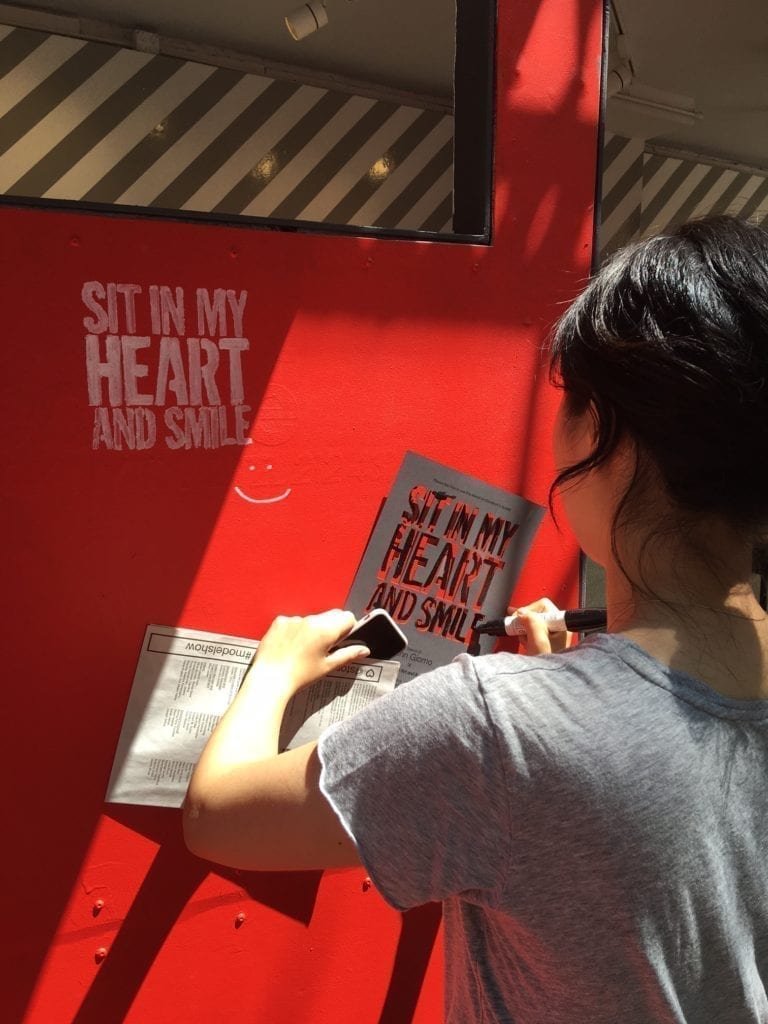
One particularly engaging element of the exhibition is that visitors are invited to participate in the show by drawing on the facade of Storefront with stencils by five different artists that expressed the sharing movement. We were among the first 100 visitors to the exhibition who received these stencils, which included phrases such as “We Love We Share” by Curtis Kulig, “Sit on My Heart and Laugh” by John Giorno, and “MY HOUSE IS YOUR HOUSE YOUR HOUSE IS MY HOUSE WHEN YOU SHIT ON THE FLOOR IT GETS ON YOUR FEET” by Lawrence Weiner. These phrases, and the interactive nature of stenciling them onto the Storefront exterior, gave us a meaningful outline of the show’s collaborative goals while also giving us a sense of public involvement that further linked us to the site and the larger city it alludes to.
As the summer winds down and we move on from our time at CIMA, we look forward to returning to rediscover the neighborhood as the artistic revival we were fortunate enough to be a part of further evolves.
—Eliza Harrison and Jamie Russell
CIMA accepts internship applications on a rolling basis. To apply, please send cover letter and resume to info@italianmodernart.org
